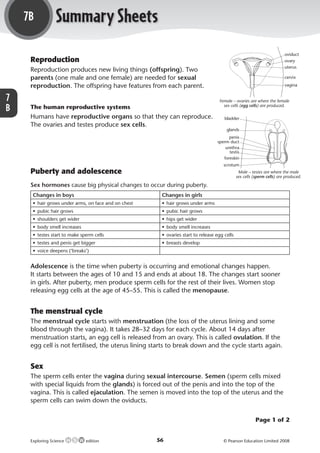More Related Content
Similar to Reproduction (20)
More from themassmaker (20)
Reproduction
- 1. 7B Summary Sheets
bladder
oviduct
Reproduction ovary
glands
uterus penis
Reproduction produces new living things (offspring). Two sperm duct
parents (one male and one female) are needed for sexual cervix urethra
testis
reproduction. The offspring have features from each parent. vagina foreskin
scrotum
7 Female – ovaries are where the female Male
B The human reproductive systems sex cells (egg cells) are produced. sex ce
Humans have reproductive organs so that they can reproduce. bladder
The ovaries and testes produce sex cells. oviduct
glands
ovary
uterus penis
sperm duct
cervix urethra
testis
vagina foreskin
scrotum
Puberty and adolescence Female – ovaries are where the female Male – testes are where the male
sex cells (egg cells) are produced. sex cells (sperm cells) are produced.
Sex hormones cause big physical changes to occur during puberty.
Changes in boys Changes in girls
• hair grows under arms, on face and on chest • hair grows under arms
• pubic hair grows • pubic hair grows
• shoulders get wider • hips get wider
• body smell increases • body smell increases
• testes start to make sperm cells • ovaries start to release egg cells
• testes and penis get bigger • breasts develop
• voice deepens (‘breaks’)
Adolescence is the time when puberty is occurring and emotional changes happen.
It starts between the ages of 10 and 15 and ends at about 18. The changes start sooner
in girls. After puberty, men produce sperm cells for the rest of their lives. Women stop
releasing egg cells at the age of 45–55. This is called the menopause.
The menstrual cycle
The menstrual cycle starts with menstruation (the loss of the uterus lining and some
blood through the vagina). It takes 28–32 days for each cycle. About 14 days after
menstruation starts, an egg cell is released from an ovary. This is called ovulation. If the
egg cell is not fertilised, the uterus lining starts to break down and the cycle starts again.
Sex
The sperm cells enter the vagina during sexual intercourse. Semen (sperm cells mixed
with special liquids from the glands) is forced out of the penis and into the top of the
vagina. This is called ejaculation. The semen is moved into the top of the uterus and the
sperm cells can swim down the oviducts.
Page 1 of 2
Exploring Science edition 56 © Pearson Education Limited 2008
M02_ES_AB_Y7_2445_U7B.indd 56 4/3/08 10:10:29
- 2. 7B Summary Sheets (continued)
The tip of the head contains
chemicals which attack
Sperm cells and egg cells The cytoplasm contains a
the coat of the egg, helping
store of food to provide
are adapted to their functions. the sperm to burrow inside.
energy for the fertilised
A sperm cell is much smaller The nucleus contains half the egg cell.
instructions needed to make
than an egg cell. a new human.
The nucleus contains half
the instructions to make a
Very little cytoplasm so that
the cell can have a thin,
new human
A jelly coat makes sure that
7
streamlined shape.
only one sperm can enter. B
The tail helps it to swim well.
An egg cell.
A sperm cell.
Pregnancy
If the egg cell meets a sperm cell in an oviduct, fertilisation can occur (the nuclei from
the two cells fuse). The fertilised egg cell divides to form a ball of cells (an embryo). The
embryo travels to the uterus where it sinks into the soft lining (implantation). The woman
is now pregnant. Once it has developed all its organs (after about 10 weeks) it is called
a foetus. It takes about 40 weeks (9 months) for a fertilised egg cell to grow into a baby
ready to be born. This time is called the gestation period.
The fertilised egg cells of many animals grow and develop outside their parents. This is
called external development. Frogs use external development. Humans use internal
development and produce fewer offspring than animals using external development
because the growing embryos are protected inside the mother.
While inside the uterus, the foetus is
supplied with oxygen and food by the
placenta
placenta. The placenta also gets rid of
amnion
waste (especially carbon dioxide) from
waste materials
the foetus. The cord (or umbilical cord) (e.g. carbon dioxide) amniotic fluid to
protect the foetus
connects the foetus to the placenta.
foetus
If a mother smokes, drinks too much
alcohol or takes drugs while pregnant,
she might damage the baby. The baby food and umbilical cord
might be premature. oxygen
mother's blood
Birth
When the baby is ready to be born, the uterus starts contractions and the woman goes into
labour. The muscles of the cervix relax. The baby is pushed out head first through the cervix
and the vagina. After birth, the baby starts to breathe and the cord is cut. The scar left behind
is the navel. After this, the placenta is pushed out of the uterus. This is the afterbirth. The
mother’s breasts contain mammary glands that produce milk to feed the baby. Breast milk
contains antibodies that help destroy microbes that might cause a disease in the baby.
Page 2 of 2
Exploring Science edition 57 © Pearson Education Limited 2008
M02_ES_AB_Y7_2445_U7B.indd 57 4/3/08 10:10:30
